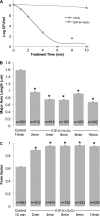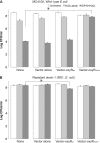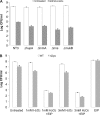Mechanisms of action of escapin, a bactericidal agent in the ink secretion of the sea hare Aplysia californica: rapid and long-lasting DNA condensation and involvement of the OxyR-regulated oxidative stress pathway
- PMID: 22232273
- PMCID: PMC3318362
- DOI: 10.1128/AAC.05874-11
Mechanisms of action of escapin, a bactericidal agent in the ink secretion of the sea hare Aplysia californica: rapid and long-lasting DNA condensation and involvement of the OxyR-regulated oxidative stress pathway
Abstract
The marine snail Aplysia californica produces escapin, an L-amino acid oxidase, in its defensive ink. Escapin uses L-lysine to produce diverse products called escapin intermediate products of L-lysine (EIP-K), including α-amino-ε-caproic acid, Δ¹-piperidine-2-carboxylic acid, and Δ²-piperidine-2-carboxylic acid. EIP-K and H₂O₂ together, but neither alone, is a powerful bactericide. Here, we report bactericidal mechanisms of escapin products on Escherichia coli. We show that EIP-K and H₂O₂ together cause rapid and long-lasting DNA condensation: 2-min treatment causes significant DNA condensation and killing, and 10-min treatment causes maximal effect, lasting at least 70 h. We isolated two mutants resistant to EIP-K plus H₂O₂, both having a single missense mutation in the oxidation regulatory gene, oxyR. A complementation assay showed that the mutated gene, oxyR(A233V), renders resistance to EIP-K plus H₂O₂, and a gene dosage effect leads to reduction of resistance for strains carrying wild-type oxyR. Temperature stress with EIP-K does not produce the bactericidal effect, suggesting the effect is due to a specific response to oxidative stress. The null mutant for any single DNA-binding protein--Dps, H-NS, Hup, Him, or MukB--was not resistant to EIP-K plus H₂O₂, suggesting that no single DNA-binding protein is necessary to mediate this bactericidal effect, but allowing for the possibility that EIP-K plus H₂O₂ could function through a combination of DNA-binding proteins. The bactericidal effect of EIP-K plus H₂O₂ was eliminated by the ferrous ion chelator 1,10-phenanthroline, and it was reduced by the hydroxyl radical scavenger thiourea, suggesting hydroxyl radicals mediate the effects of EIP-K plus H₂O₂.
Figures










Similar articles
-
Cloning, characterization and expression of escapin, a broadly antimicrobial FAD-containing L-amino acid oxidase from ink of the sea hare Aplysia californica.J Exp Biol. 2005 Sep;208(Pt 18):3609-22. doi: 10.1242/jeb.01795. J Exp Biol. 2005. PMID: 16155232
-
Identification of potent bactericidal compounds produced by escapin, an L-amino acid oxidase in the ink of the sea hare Aplysia californica.Antimicrob Agents Chemother. 2008 Dec;52(12):4455-62. doi: 10.1128/AAC.01103-08. Epub 2008 Oct 13. Antimicrob Agents Chemother. 2008. PMID: 18852282 Free PMC article.
-
Molecules and Mechanisms Underlying the Antimicrobial Activity of Escapin, an l-Amino Acid Oxidase from the Ink of Sea Hares.Biol Bull. 2018 Aug;235(1):52-61. doi: 10.1086/699175. Epub 2018 Jul 30. Biol Bull. 2018. PMID: 30160994
-
The OxyR regulon.Antonie Van Leeuwenhoek. 1990 Oct;58(3):157-61. doi: 10.1007/BF00548927. Antonie Van Leeuwenhoek. 1990. PMID: 2256675 Review.
-
OxyR: a regulator of antioxidant genes.J Nutr. 1992 Mar;122(3 Suppl):627-30. doi: 10.1093/jn/122.suppl_3.627. J Nutr. 1992. PMID: 1542022 Review.
Cited by
-
Bacterial Vivisection: How Fluorescence-Based Imaging Techniques Shed a Light on the Inner Workings of Bacteria.Microbiol Mol Biol Rev. 2020 Oct 28;84(4):e00008-20. doi: 10.1128/MMBR.00008-20. Print 2020 Nov 18. Microbiol Mol Biol Rev. 2020. PMID: 33115939 Free PMC article. Review.
-
Stress-induced condensation of bacterial genomes results in re-pairing of sister chromosomes: implications for double strand DNA break repair.J Biol Chem. 2013 Aug 30;288(35):25659-25667. doi: 10.1074/jbc.M113.473025. Epub 2013 Jul 24. J Biol Chem. 2013. PMID: 23884460 Free PMC article.
-
Distribution in Different Organisms of Amino Acid Oxidases with FAD or a Quinone As Cofactor and Their Role as Antimicrobial Proteins in Marine Bacteria.Mar Drugs. 2015 Dec 16;13(12):7403-18. doi: 10.3390/md13127073. Mar Drugs. 2015. PMID: 26694422 Free PMC article. Review.
-
Redox-dependent condensation of the mycobacterial nucleoid by WhiB4.Redox Biol. 2018 Oct;19:116-133. doi: 10.1016/j.redox.2018.08.006. Epub 2018 Aug 13. Redox Biol. 2018. PMID: 30149290 Free PMC article.
-
Atmospheric Nonthermal Plasma-Treated PBS Inactivates Escherichia coli by Oxidative DNA Damage.PLoS One. 2015 Oct 13;10(10):e0139903. doi: 10.1371/journal.pone.0139903. eCollection 2015. PLoS One. 2015. PMID: 26461113 Free PMC article.
References
Publication types
MeSH terms
Substances
Grants and funding
LinkOut - more resources
Full Text Sources
Medical
Research Materials
Miscellaneous

